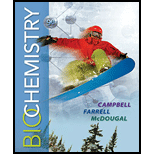
Concept explainers
RECALL Proteins,
Interpretation:
The basis for grouping substances such as lipids is to be defined.
Concept Introduction:
Proteins, carbohydrates and nucleic acids are the polymers of amino acid residues, sugar residues and nucleotides, respectively.
Saturated hydrocarbons contain only single-bonded carbon atoms, and unsaturated hydrocarbons contain multiple double or triple bonds.
Electronegativity is the property of an atom to pull electrons towards itself.
Answer to Problem 1RE
Solution:
Lipids are grouped only on the basis of solubility and non-polar nature of their molecules, whereas, some lipids do not share any structural similarity, like, groups if proteins, carbohydrates and nucleic acids.
Explanation of Solution
The amino acid residues are linked together by peptide bonds and polymerize to form a peptide chain, which eventually gives rise to a protein structure. The sugar molecules like glucose are linked together by glycosidic linkages to form a polymer of carbohydrate. DNA (deoxyribonucleic acid) is a polymer of deoxynucleotides, like, adenine, guanine, cytosine, and thymine. Carbohydrates have carbon, hydrogen, and oxygen in their structures. Proteins have amino and carboxyl groups in their structures. The nucleic acids have phosphate, sugar residue and a nitrogenous base in their structures. It suggests that all these molecules are grouped on the basis of some common groups or atoms that are constant in their structure.
The lipids are grouped on the basis of their hydrophobic nature, that is, the fear of water. The lipids are not soluble in water because of the presence of a hydrocarbon chain which is non-polar in nature. Polar molecules are those molecules that contain opposite charges on their molecules, for example, water. In water (
Lipids, sometimes, do not share a common structure. For example, the lipid compounds that carry long hydrophobic hydrocarbon chains and polar head groups are classified as fatty acids, sphingolipids, glycolipids, triacylglycerol, and others. The lipids that contain fused ring structures are grouped as steroids, and cholesterol is the most common type of steroid.
The lipids are grouped on the basis of solubility and non-polar nature. Also, some lipids are not structurally related.
Want to see more full solutions like this?
Chapter 8 Solutions
Biochemistry
- RECALL Are amino acids other than the usual 20 amino acids found in proteins? If so, how are such amino acids incorporated into proteins? Give an example of such an amino acid and a protein in which it occurs.arrow_forwardRECALL What is the structure of ATCase?arrow_forwardRECALL What is qPCR?arrow_forward
- RECALL How can gel-filtration chromatography be used to arrive at an estimate of the molecular weight of a protein?arrow_forwardREFLECT AND APPLY Glycine is a highly conserved amino acid residue in proteins (i.e., it is found in the same position in the primary structure of related proteins). Suggest a reason why this might occur.arrow_forwardREFLECT AND APPLY Nucleic acids are polymers of just four different monomers in a linear arrangement. How many different sequences are available if one makes a polymer with only 40 monomers? How does this number compare with Avogadros number?arrow_forward
- REFLECT AND APPLY Compare the information in the sequence of monomers in a polysaccharide with that in the sequence of amino acid residues in a protein.arrow_forwardRECALL Is it possible to form cyclic peptides without bonds between side chains of the component amino acids?arrow_forwardREFLECT AND APPLY Suggest an explanation for the observation that when proteins are chemically modified so that specific side chains have a different chemical nature, these proteins cannot be denatured reversibly.arrow_forward
- REFLECT AND APPLY Common proteins are polymers of 20 different amino acids. How big a protein (how many amino acid residues) would be necessary to have an Avogadros number of possible sequences?arrow_forwardRECALL What is the critical amino acid difference between the -chain and the -chain of hemoglobin?arrow_forwardRECALL What causes protein aggregates to form?arrow_forward
 BiochemistryBiochemistryISBN:9781305961135Author:Mary K. Campbell, Shawn O. Farrell, Owen M. McDougalPublisher:Cengage Learning
BiochemistryBiochemistryISBN:9781305961135Author:Mary K. Campbell, Shawn O. Farrell, Owen M. McDougalPublisher:Cengage Learning
